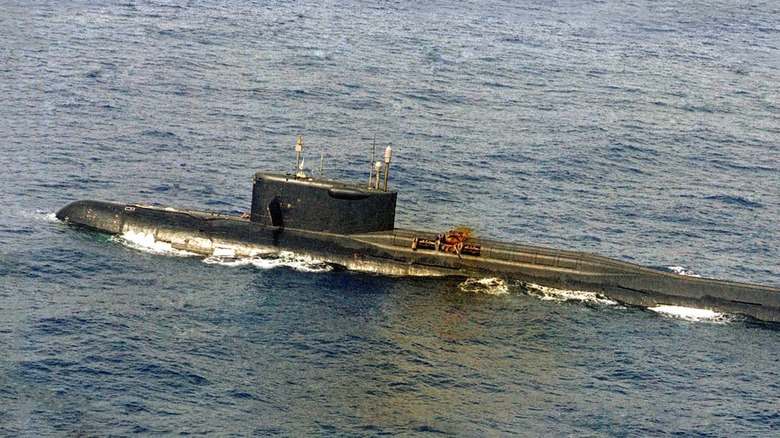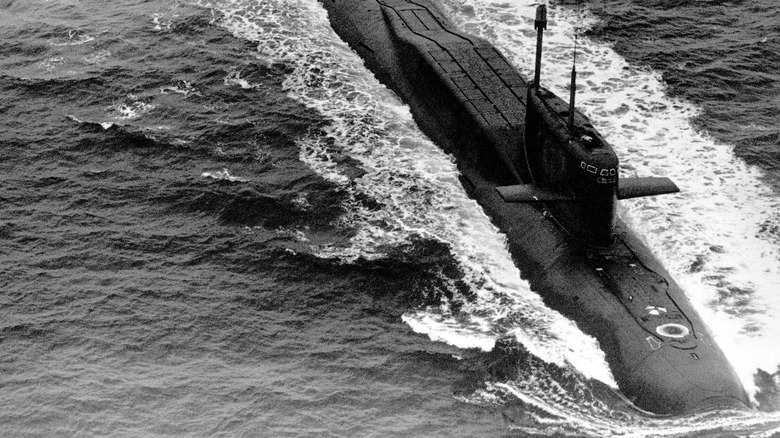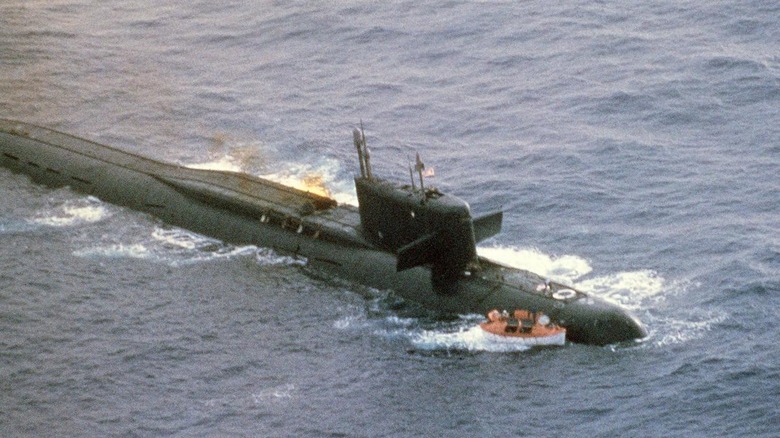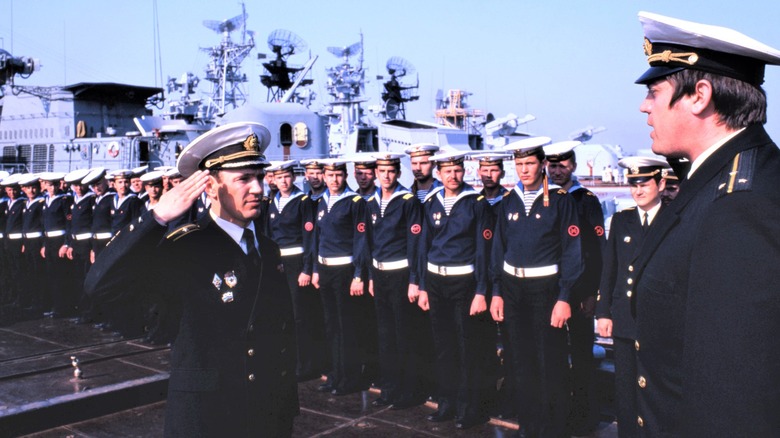This Soviet Submarine Narrowly Avoided Nuclear Disaster: Here's What Went Wrong
Submarines give nations unprecedented stealth capabilities, allowing them to sink enemy ships without exposing themselves visually and even threaten cities with mass destruction. However, even though the first submarine was made in 1620, and the modern submarine made its debut in the 1880s, sailing one is still an inherently dangerous endeavor.
For example, the American nuclear submarine USS Thresher sank in 1963, the Russians lost the Kursk nuclear submarine in 2000, and the Indonesian Navy lost the KRI Nanggala submarine in 2021. All of these events lead to the loss of all hands, showing the dangers of submarine operations.
Military operations are often highly classified, which is why knowing about a submarine disaster is usually big news among the general public. And when you add nuclear weapons into the mix, you get a truly sensational story. This is exactly what happened in October 1986, when a Soviet sub had an accident with its nuclear missiles.
[Featured image by the U.S. Navy via Wikimedia Commons | Cropped and scaled | Public Domain]
What was the K-219?
The submarine involved in the 1986 disaster was the K-219, a Navaga Class nuclear ballistic missile sub (SSBN) with the NATO designation of Yankee-class. The Soviets introduced this submarine class in 1967 to counter the thermonuclear Polaris missiles used by the Americans in their SSBNs. Although the K-219 was at the cutting edge of Soviet technology when it launched in 1971, it was almost 15 years old by the time of the accident.
Despite its age, the sub was still a dangerous strategic asset, as it carried 16 R-27 Zyb missiles (called SS-N-6 'Serb' by NATO) with a 1,600 nautical mile range. The latest variant of the missile, the R-27 Mod 3, had the capability to be armed with three 200 kT warheads each, giving the submarine a formidable maximum loadout.
At the time of the accident, the sub was patrolling the seas off the west coast of the U.S., about 700 miles from Bermuda. This was a routine mission for the Soviet SSBN fleet during the Cold War when they would patrol international waters off the coast of America, allowing them to launch strike missions at a moment's notice in case of nuclear war.
[Featured image by the U.S. Navy via Wikimedia Commons | Cropped and scaled | Public Domain]
A dangerous design for its missles
The R-27 Mod 3 missile will play a key role in the K-219's accident. This submarine-launched ballistic missile was first introduced in 1967, the same year as the K-219's launch, and was deployed in 1969. Unlike the Polaris missile, which the Americans and British used around the same time and featured solid rocket fuel, the Serb used liquid fuel stored within the missile body.
This was similar to the land-based Titan and Titan II missiles the U.S. had in its arsenal. However, these missiles stored their fuel elsewhere, thus requiring them to be fueled before launch. On the other hand, the Soviets could launch the R-27s in less than ten minutes, owing to the fact that it was already pre-fueled even before the sub left port.
Keeping the missiles fueled saves time for the launch crew (and space aboard a cramped submarine). However, this system has one major downside: the Dinitrogen tetroxide used as the oxidizer for the missile is highly toxic and corrosive, especially when mixed with seawater.
Poor maintenance and training led to disaster
According to Capt. Ilya B. Kolton, a veteran Soviet submarine force commander, "Construction deficiencies, plus imperfect crew rescue equipment, plus the startling slowness and inertia of the naval agencies in introducing new ideas — such, in my opinion, is the alarming formula of the recent emergencies and tragedies." This was his comment when he wrote to Komsomolskaya Pravda, a Soviet publication, in 1989, according to The National Interest.
At the time of the accident, the Soviets were extending the deployments of their nuclear submarines, which led to reduced maintenance work on the boats and training for its crews. It was the confluence of these factors that directly led to the mishap.
The K-219's Missile Tube Number 6 suffered a ruptured seal, allowing seawater to get into the silo. This then mixed with the oxidizer in the R-27 missile, creating nitric acid, which easily dissolves metals and other materials. As the acid ate away at the tanks separating the oxidizer and the fuel in the missile body, it created a mix of highly volatile materials and deadly nitrogen dioxide gas.
[Featured image by the U.S. Navy via Wikimedia Commons | Cropped and scaled | Public domain]
A heroic sacrifice
This dangerous mix soon ignited, instantly killing two sailors, while the missile officer was soon overcome by the toxic fumes. The explosion also damaged the submarine to the point that water came pouring in, causing it to lose buoyancy and sink more than 800 feet. It was only the last-ditch attempt of blowing all tanks that saved the ship from sinking with all its crew aboard. Aside from the casualties and the damage to the submarine, the explosion also expelled the nuclear warheads of the affected missile into the ocean. Thankfully, this did not result in an unintended nuclear explosion, although it did scatter radioactive debris.
Unfortunately, the explosion also started several fires that made the reactor controls unresponsive. Unless the crew could shut off the boat's nuclear reactor, a meltdown like what happened at Chernobyl a few months earlier, could occur. Two crew members volunteered to lower the control rods that will stop the reactor: Lieutenant Belikov and Apprentice Sergei Preminin. The two were able to lower three of the four control rods before Preminin collapsed. Belikov carried him to safety and returned to finish the fourth rod, but he lost consciousness himself before being able to do so. When Preminin regained consciousness, he went back into the reactor and pulled the Lieutenant out before going back to finish the job.
Sergei Preminin successfully shut down the reactor. However, he ran out of oxygen before he could escape and died in the reactor compartment. For his bravery, Sergei Preminin was posthumously awarded the Order of the Red Star and the medal of the Hero of the Russian Federation.
Soviet actions on the K-219's loss
The crew was eventually able to evacuate the stricken submarine when Soviet merchant vessels arrived at the scene to assist. They even attempted to tow the K-219 back to its home port thousands of miles away. However, the tow line broke, and the submarine soon slipped beneath the waves. When the crew got back to Soviet Russia, the commander of K-219, Submarine Commander Captain Second rank, Igor Britanov, was blamed for the accident. He was initially accused of negligence, sabotage, and treason, but all charges were eventually dropped in 1987.
On the other hand, the Soviet leadership immediately notified their American counterparts about the accident — an unprecedented move given that the Chernobyl disaster, which happened just months before, was initially covered-up. Although there were some concerns that the Americans would try to steal Soviet technology from the K-219, the Chief of Navy, Admiral Vladimir Chernavin, assured the Politburo that the submarine was an old design and that the Americans weren't interested in it.
Despite the accident happening just a few days before the Reykjavik summit of 1986, wherein Reagan and Gorbachev were to discuss limiting the nuclear stockpiles of both the U.S. and Soviet Russia, the K-219 accident didn't seem to have a negative effect on the relations between the two superpowers. This showed the thawing of relations between the two, especially as this event happened during the closing years of the Cold War.





